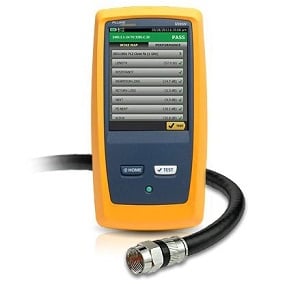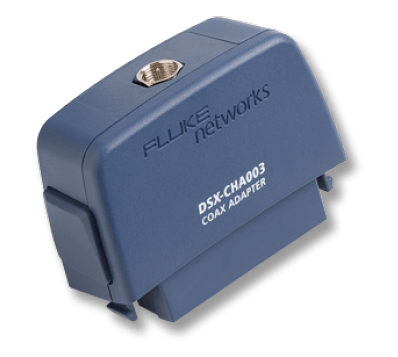Coax Cable – You Might Just Need to Test It
August 29, 2018 / General, Installation and testing, Industrial Networks, Best Practices
When it comes to copper testing, we talk a lot about category balanced twisted-pair copper cabling like Category 6, Category 6A and Category 8. And although this cabling type is widely deployed to support everything Ethernet transmission of voice, data and video, that doesn’t mean it’s the only copper cabling you could encounter.
Coaxial cabling (sometimes just “coax” for short) has long been used for distribution of data and video signals, and it was one of the first media to support Ethernet with 10BASE2 and 10BASE5 that transmitted 10 Mb/s up to 185 meters or 500 meters, respectively. The term “coaxial” refers the fact that the cable’s center conductor and shield share the same axis, or center point. Some coaxial cable may include multiple shields, such as a quad shielded coax that includes two layers that each consist of a braided shield over a foil shield. It’s the shielding that makes coaxial cable highly resistant to electromagnetic interference and able to carry high frequency signals over long distances.
While we often think of coax as being only deployed in residential applications for broadband video and cable TV (CATV), it can still be found in commercial enterprise environment for everything from closed circuit television (CCTV), audio and video, to radio antenna and even some network connections. It therefore makes sense to understand this cable media and how to test it.

The Primary Types
There are several different types of coax cables to support a wide range of specialty applications, such as satellite communications, industrial, military and marine applications. The three most common non-industrial coax types are RG6, RG11 and RG59, with RG6 being the most common type you will likely encounter in the enterprise for applications like CCTV and CATV. RG11 has a larger center conductor than RG6, which means it has lower insertion loss and can transmit signals further than RG6. However, thicker RG11 cables cost more and are extremely inflexible, making them impractical for deployment in premise applications and better suited for use in longer-run outside plant installations or for straight backbone links. RG59 is more flexible than RG6, but it features even higher loss and is rarely used anymore except in low-bandwidth, low-frequency analog video applications where distances are short and pathway space is limited (think back-up camera in your car).
Coaxial cables also come in various impedances—typically 50, 75 and 93 ohm. 50 ohm coaxial offers higher power handling and is primarily used for radio transmitters like Ham radios, CBs and walkie-talkies. 75 ohm cable does a better job of maintaining signal strength and is primarily used for connecting any type of receiving device such as CATV receivers, high-definition TVs and digital recorders. Originally used in mainframe IBM networks in the 1970s and early 1980s, 93 ohm coax is rare and expensive. While 75 ohm coax is likely the impedance you will encounter in most present-day applications, it’s important to note that all components in a coaxial cabling system should have the same impedance to avoid internal reflections at connection points that can cause signal loss and poor video quality.
Digital Signal 3 (DS3) signals used to carry traffic in central offices (also referred to as a T3 line) also use coaxial cable, including 75 ohm Type 735 and Type 734. Type 735 cable can be used to cover distances up to 69 meters, while Type 734 cable can be used up to 137 meters. RG6 cable may also be used to carry DS3 signals but over shorter distances.
Testing Made Easy
For any coaxial cable, a successful installation is dependent on the use of high quality components and proper installation techniques, especially installation of connectors. Insertion loss, which is affected by the overall length of the installed link, is the primary parameter that ensures coaxial cabling will support the intended application.
ANSI/TIA-568-4.D specifies requirements for 75 ohm broadband coaxial cabling, cords and connecting hardware to support CATV, satellite television and other broadband applications. For the Cabling Subsystem 1 between the outlet and the first distribution point, the length limit is 46 meters for RG6 and 90 meters for RG11. For a Cabling Subsystem 2 between distribution points, the length limit remains at 46 meters for RG6 and increases to 100 meters for RG11. For each of these deployments, TIA-568-4.D specifies insertion loss limits over the frequency range of 5 to 1002 MHz.
Testing is made easy with Fluke Networks’ DSX-CHA003 Coax Adapter for use with DSX CableAnalyzer™ Series Copper Cable Certifiers. With support for RG6 and RG11 coaxial cabling, the DSX-CHA003 Coax Adapter tests to the TIA insertion loss limits over the full frequency range. Because insertion loss is strongly influenced by the length of the installed link whereby a shorter link may pass even when performance has been significantly degraded by cable damage or poorly installed connectors, the DSX CableAnalyzer also provides Length-Scaled test limits that automatically adjust insertion loss limit based on the actual measured length of the cabling segment.

The DSX CableAnalyzer also provides Length-Scaled DS-3 test limits for Type 734, Type 735 and RG6 coaxial cabling used in central office applications. And while only encountered in rare lower-speed applications where a distance greater than 100 meters is required, the DSX CableAnalyzer can also test 50 ohm coaxial cabling used to support legacy 10BASE2 or 10BASE5 Ethernet.






